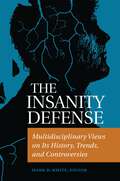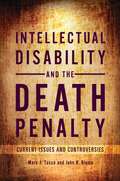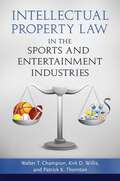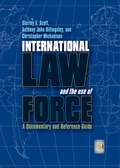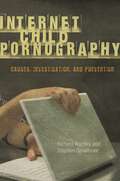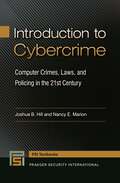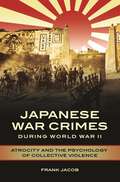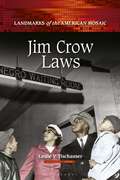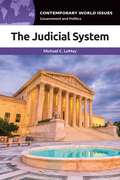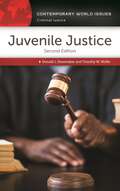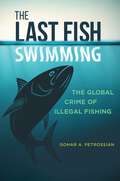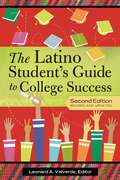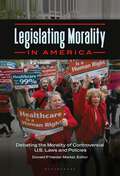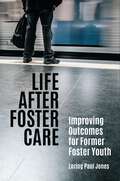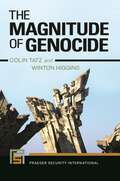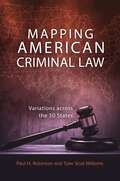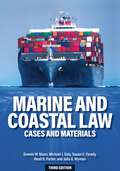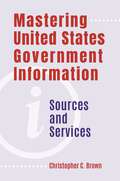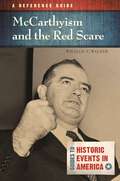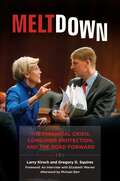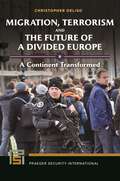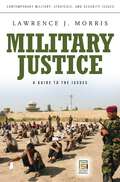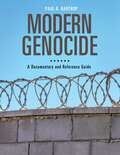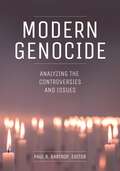- Table View
- List View
Infertility Treatments (Health and Medical Issues Today)
by Janice ArenofskyInfertility affects about five million individuals of childbearing age in the United States, yet infertility is a subject about which many people are reluctant to talk. This book discusses extensively many options available to individuals struggling with infertility.Infertility can result from a number of causes and affects men and women in equal numbers. Difficulty conceiving can take a heavy toll on couples both physically and psychologically and can lead to depression and marital discord. There are, however, many options available to those struggling with infertility for having a child. These include innovative medical procedures and powerful drugs as well as a variety of alternative treatment approaches, surrogacy, and adoption.A part of Greenwood's Health and Medical Issues Today series, this book provides an overview of these options and examines the many health, financial, and ethical decisions of each that must be considered when choosing one. Part I explores what causes infertility and the history and evolution of its treatment and then examines the options available today, detailing how they work, their success rates, and their risks. Additionally, it addresses controversial topics such as the legislation of assisted reproductive technologies and the regulation of fertility clinics. Part II delves into the many scientific, economic, and ethical debates that surround infertility treatment, presenting a clear and objective analysis of the issues. Part III provides a variety of useful supplementary materials, including case studies, a timeline of critical events, a glossary, and a directory of resources.
The Insanity Defense: Multidisciplinary Views on Its History, Trends, and Controversies
by Mark D. White, EditorHow often is the defense of insanity or temporary insanity for accused criminals valid—or is it ever legitimate? This unique work presents multidisciplinary viewpoints that explain, support, and critique the insanity defense as it stands.What is the role of "the insanity defense" as a legal excuse? How does U.S. law handle criminal trials where the defendant pleads insanity, and how does our legal system's treatment differ from those of other countries or cultures? How are insanity defenses used, and how successful are these defenses for the accused? What are the costs of incarceration versus psychiatric treatment and confinement?This book presents a range of expert viewpoints on the insanity defense, exposing common myths; investigating its effectiveness and place in our legal system through history, case studies, and comparative analysis; and supplying perspectives from the disciplines of psychology, psychiatry, sociology, and neuroscience. The content also addresses the ramifications of declaring citizens insane or incapacitated and examines trials that involved pleas of insanity and temporary insanity.
Intellectual Disability and the Death Penalty: Current Issues and Controversies
by Marc J. Ph.D. John H. MARProviding key information for students or professionals in the fields of criminology, education, psychology, law, and law enforcement, this book documents the legal and clinical aspects of the issues related to intellectual disability and the death penalty.Written by two nationally recognized experts, this book provides a comprehensive review of the legal and clinical aspects of the death penalty as it relates to intellectual disability. First, the facts: people with intellectual disability may falsely confess to a crime because they want to please the authorities, and they are often less able than others to work with lawyers to prepare a defense. In addition, because of the stigma attached to intellectual disability, affected individuals often become adept at hiding it, even from their attorney, not understanding the condition's importance to the outcome of their case.Having explained such harsh realities and presented a comprehensive review of what intellectual disability is, the book focuses on the 2002 U.S. Supreme Court Atkins v. Virginia decision granting a death penalty exemption to individuals with intellectual disability. It outlines best practice regarding the determination of intellectual disability and discusses qualifications needed for experts in such cases. Related issues such as common misconceptions regarding people with intellectual disability, race, socioeconomic status, and the status of foreign nationals as it relates to the death penalty and intellectual disability are discussed as well. A must-have resource for prosecutors, defense lawyers, and clinicians providing expert testimony in death penalty cases, this book will also prove absorbing reading for anyone concerned about this troubling issue.
Intellectual Property Law in the Sports and Entertainment Industries
by Walter T. Champion Kirk D. WillisIn this detailed yet readable legal analysis, the authors thoroughly evaluate the connections between intellectual property and the sports and entertainment industries, covering everything from copyrights and patents to trademarked logos and marketing strategies.This complete survey of intellectual property law in the sports and entertainment industries evaluates the key connections between these arenas and provides an overview of trademark law for sports. The authors clearly explain the rights of publicity and privacy for entertainers and athletes, the ethical considerations involved in obtaining and using intellectual property, and how licensing agreements relate to intellectual property law. The detailed, up-to-date legal analyses are written by practitioners in the field for those without legal expertise, yet still contain useful information to the legal community. The book covers all forms of intellectual property, including copyright, patents, trademarks, trade dress, trade secrets, and the right of publicity. It will also discuss marketing, broadcasting, films and books, sports equipment, international considerations and trade issues, and intellectual property in cyberspace.
International Law and the Use of Force: A Documentary and Reference Guide (Praeger Security International)
by Shirley V. Scott Anthony John Billingsley Dr Christopher MichaelsenThis book is a discussion of key documents that explain the development, current status, and relevance of the international law governing the initiation of military hostilities.International Law and the Use of Force: A Documentary and Reference Guide brings to life a crucial body of law, explaining its historical origins, the core rules and principles of the regime embodied in the Charter of the United Nations, and contentious aspects of that law in the contemporary world. In light of the intensified interest in the question of justified or unjustified use of force, this timely resource introduces and analyzes over 40 documents relating to the legality of the initiation of military hostilities. The volume presents competing assessments of the legality of key uses of force and explains mainstream positions on important issues such as national right to self-defense, anticipatory and preemptive self-defense, terrorism, aggression, and the role of the UN Security Council. The book concludes by assessing whether the international law that seeks to limit the number of wars has in fact made the world a more peaceful place.
Internet Child Pornography: Causes, Investigation, and Prevention (Global Crime and Justice)
by Richard Wortley Stephen SmallboneThis book provides a comprehensive introduction to the problem of Internet child pornography that spotlights the connection between technology and behavior, presenting practical suggestions for reducing this pervasive problem.The role of the Internet in fueling the problem of child pornography is enormous. Prior to the Internet, child pornography was typically locally produced, of poor quality, expensive, and difficult to obtain. United States' law enforcement officials were able to boast in the late 1970s that the traffic in child pornography had virtually been eliminated. The advent of the Internet in the 1980s made vast quantities of child pornography instantly available in the privacy of the viewer's home. Today, child pornography largely exists because of the opportunities provided by the Internet.Internet Child Pornography provides a comprehensive overview of the issue by describing the problem of child pornography, examining the impact of the Internet, and presenting a profile of users. With this foundation in place, the authors then address responses to child pornography and shed light on the complexities of dealing with criminal activities that are perpetrated largely online—for example, the fact that people behave differently in online environments than they do in other areas of their lives. The book examines prevention efforts designed to reduce access to child pornography, law enforcement responses designed to catch known offenders, and treatment responses designed to reduce reoffending.
Introduction to Cybercrime: Computer Crimes, Laws, and Policing in the 21st Century (Praeger Security International Textbook)
by Joshua B. Hill Nancy E. MarionExplaining cybercrime in a highly networked world, this book provides a comprehensive yet accessible summary of the history, modern developments, and efforts to combat cybercrime in various forms at all levels of government—international, national, state, and local.As the exponential growth of the Internet has made the exchange and storage of information quick and inexpensive, the incidence of cyber-enabled criminal activity—from copyright infringement to phishing to online pornography—has also exploded. These crimes, both old and new, are posing challenges for law enforcement and legislators alike. What efforts—if any—could deter cybercrime in the highly networked and extremely fast-moving modern world? Introduction to Cybercrime: Computer Crimes, Laws, and Policing in the 21st Century seeks to address this tough question and enables readers to better contextualize the place of cybercrime in the current landscape.This textbook documents how a significant side effect of the positive growth of technology has been a proliferation of computer-facilitated crime, explaining how computers have become the preferred tools used to commit crimes, both domestically and internationally, and have the potential to seriously harm people and property alike. The chapters discuss different types of cybercrimes—including new offenses unique to the Internet—and their widespread impacts. Readers will learn about the governmental responses worldwide that attempt to alleviate or prevent cybercrimes and gain a solid understanding of the issues surrounding cybercrime in today's society as well as the long- and short-term impacts of cybercrime.
Japanese War Crimes during World War II: Atrocity and the Psychology of Collective Violence
by Frank JacobA challenging examination of Japanese war crimes during World War II offers a fresh perspective on the Pacific War—and a better understanding of reasons for the wartime use of extreme mass violence.The 1937 Rape of Nanjing has become a symbol of Japanese violence during the Second World War, but it was not the only event during which the Japanese used extreme force. This thought-provoking book analyzes Japan's actions during the war, without blaming Japan, helping readers understand what led to those eruptions. In fact, the author specifically disputes the idea that the forms of extreme violence used in the Pacific War were particularly Japanese.The volume starts by examining the Rape of Nanjing, then goes on to address Japan's acts of individual and collective violence throughout the conflict. Unlike other works on the subject, it combines historical, sociological, and psychological perspectives on violence with a specific study of the Japanese army, seeking to define the reasons for the use of extreme violence in each particular case. Both a historical survey and an explanation of Japanese warfare, the book scrutinizes incidents of violence perpetrated by the Japanese vis-à-vis theories that explore the use of violence as part of human nature. In doing so, it provides far-reaching insights into the use of collective violence and torture in war overall, as well as motivations for committing atrocities. Finally, the author discusses current political implications stemming from Japan's continued refusal to acknowledge its war-time actions as war crimes.
Jim Crow Laws (Landmarks of the American Mosaic)
by Leslie V. TischauserThis disquieting yet important book describes the injustices, humiliations, and brutalities inflicted on African Americans in a racist culture that was created—and protected—by the forces of law and order.Jim Crow Laws presents the history of the discriminatory laws that segregated people by race in the American South from the end of the Civil War through passage of the 1965 Civil Rights Act. To paint a true picture of these deplorable restrictions, this book provides a detailed analysis of the creation, defense, justification, and fight against the Jim Crow system.Among the subjects covered here are the origins of legal inequality for African Americans in the aftermath of the Civil War; the role of the U.S. Supreme Court in weakening constitutional protections against discrimination established in the 13th, 14th, and 15th Amendments; the white justification of segregation; and the extreme brutality of Jim Crow's defenders. Equally important, readers will learn about the psychological, political, social, and economic costs endured by the victims of Jim Crow inequality, as well as about the motivations, rejections, and successes faced by those who stood against these abominations.
The Judicial System: A Reference Handbook (Contemporary World Issues)
by Michael C. LeMayThe Judicial System: A Reference Handbook provides an authoritative and accessible one-stop resource for understanding the U.S. judicial system and its place in the fabric of American government and society.The American judicial system plays a central role in setting and enforcing the legal rules under which the people of the United States live. U.S. courts and laws, though, are complex and often criticized for bias and other alleged shortcomings, The U.S. Supreme Court has emerged as a particular focal point of political partisanship and controversy, both in terms of the legal decisions it hands down and the makeup of its membership.Like other books in the Contemporary World Issues series, this volume comprises seven chapters. Chapter 1 presents the origins, development, and current characteristics of the American judicial system. Chapter 2 discusses problems and controversies orbiting around the U.S. justice system today. Chapter 3 features a wide-ranging collection of essays that examine and illuminate various aspects of the judicial system. Chapter 4 profiles influential organizations and people related to the justice system, and Chapter 5 offers relevant data and documents about U.S. courts. Chapter 6 is composed of an annotated list of important resources, while Chapter 7 offers a useful chronology of events.
Juvenile Justice: A Reference Handbook (Contemporary World Issues)
by Donald J. Shoemaker Timothy W. WolfeAuthoritative, current, and easy to use, this book is an outstanding resource for readers looking to gain an accurate and thorough understanding of American juvenile justice.Juvenile delinquency has been of interest to the general public and academic scholars for many decades—and it has been an ongoing societal problem for the same amount of time. Delinquency covers a range of behaviors from minor offenses, such as trespassing or vandalism, to the more serious crimes often associated with gangs that include murder. Juvenile Justice: A Reference Handbook puts juvenile justice under the microscope, surveying its long history and key issues, exploring the myriad of problems and controversies tied to the juvenile justice system, and explains how policymakers and legal professionals have tried to solve these vexing issues.The book first presents historical and contemporary discussions of juvenile justice, especially in the United States. The next chapters address problems, controversies, and possible solutions for juvenile justice; present insightful, diverse perspectives from leading experts; and profile important figures in the juvenile justice system and the field of crime and delinquency. The book also contains data and primary documents that show who gets processed through the juvenile justice system and for what kinds of criminal acts.
The Last Fish Swimming: The Global Crime of Illegal Fishing (Global Crime and Justice)
by Gohar A. PetrossianThis book examines the global, local, and specific environmental factors that facilitate illegal fishing and proposes effective ways to reduce the opportunities and incentives that threaten the existence of the world's fish.Humans are deeply dependent on fishing—globally, fish comprise 15 percent of the protein intake for approximately 3 billion people, and 8 percent of the global population depends on the fishing industry as their livelihood. The global fishing industry is plagued by illegal fishing, however, and many highly commercial species, such as cod, tuna, orange roughy, and swordfish, are extremely vulnerable. Through criminological analysis, The Last Fish Swimming emphasizes the importance of looking at specific environmental factors that make illegal fishing possible. It examines such factors as proximity to known ports where illegally caught fish can be landed without inspection (i.e., ports of convenience), fisheries monitoring, control and surveillance efforts, formal surveillance, and resource attractiveness in 53 countries that altogether represent 96 percent of the world's fish catch. The book calls upon the global community to address the illegal depletion of the world's fish stock and other similar threats to the world's food supply and natural environment in order to ensure the sustainability of the planet's fish and continuation of the legal fishing industry for generations to come.
The Latino Student's Guide to College Success
by Leonard A. ValverdeThis book provides Latino students with a step-by-step roadmap for navigating the college process—from overcoming cultural barriers to attending college, to selecting the right school, to considering advanced degrees.The Latino community is the fastest growing minority group in America, and quickly becoming a major player in America's workforce. Unfortunately, Latinos encounter cultural and societal obstacles that can hinder academic achievement. This inspirational guide gives Latino students practical skills for advancing in a college environment.The Latino Student's Guide to College Success: Second Edition, Revised and Updated provides a blueprint for collegiate success. The first eight chapters guide students through subjects such as selecting a college, navigating the application process, forming effective study habits, accessing student support services, and planning for advanced degrees. The second part is comprised of eight inspirational stories by Latino graduates sharing their college experiences. Lastly, a third section features a listing of colleges with a record of graduating the most Latinos, as well as a list of the top ten colleges with the most undergraduate Latino students. The revised and updated second edition of this popular book features the latest economic and demographic changes that have emerged since the first edition was published. It also includes six new chapters introducing the impact of technological advancements and changes in cultural trends.
Legislating Morality in America: Debating the Morality of Controversial U.S. Laws and Policies
by Donald P. Haider-MarkelThis title undertakes an impartial, authoritative, and in-depth examination of the moral arguments and ideas behind the laws and policies that govern personal, corporate, and government behavior in the United States.This A–Z encyclopedia surveys the moral arguments that provide the foundation for many of the most important and/or divisive laws, policies, and beliefs that govern modern American society. The work discusses such controversial and important issues as abortion, civil rights, drugs and alcohol, euthanasia, guns, hate crimes, immigration, immunization, natural resource use and protection, prostitution, same-sex marriage, and workplace laws. In the process of surveying historical and current beliefs about appropriate legislative responses to these issues, this work will help readers to understand how conservative and liberal conceptions of justice, fairness, and morality are at the center of so many hot-button political and social issues in 21st century America. The essays featured in the volume cover wide-ranging and controversial topics related to constitutional and religious freedoms, crime and punishment, sexuality and reproduction, environmental protection and public health, national security and civil liberties, social welfare programs, and education.
Life after Foster Care: Improving Outcomes for Former Foster Youth
by Loring Paul JonesThis book apprises readers of the present conditions of former and emancipated foster youth, provides evidence-based best practices regarding their experiences, and proposes new policies for ensuring better outcomes for these children upon discharge from foster care.For most American youth, the transition to adulthood is gradual and aided by support from parents and others. In contrast, foster youth are expected to arrive at self-sufficiency abruptly and without the same level of support. Such an expectation may be due in part to what Loring Paul Jones has found in his research: that many of the studies conducted thus far have been fragmented and incomplete, often focusing on a particular state or agency that may follow policies not applicable nationwide. This book connects the dots between these disparate studies to provide child welfare practitioners, policy makers, and students with a broader picture of the state of American youth following discharge from foster care. It examines not only child welfare policies but also related policies in areas such as housing and education that may contribute to the success or failure of foster youth in society. It additionally draws lessons from successful programs to provide readers with the tools needed to develop foster and after-care systems that more closely mirror the support afforded to youth in the general population.
The Magnitude of Genocide (Praeger Security International)
by Colin Tatz Winton HigginsThis book defines genocide, distinguishing it from mass murder, war crimes, and other atrocities; allows readers to grasp the magnitude of the crime of genocide across time and throughout human civilization; and facilitates an understanding of new and potential cases of genocide as they occur.Recently, the topic of intervention against genocide has received attention in global politics and the national political discourse of major countries. The challenges in confronting genocide and attempting to make a positive change are manifold. Simply establishing an agreement on the legal definition of genocide—and distinguishing it from genocidal massacres, war crimes, and other crimes against humanity—is problematic. This book provides a valuable resource for students, scholars, and journalists when public awareness of, and interest in, genocide has reached unprecedented levels. Written in an accessible way for a broad readership, the book makes use of case studies to enable an understanding of emerging and potential genocide with the necessary depth of coverage to evaluate critically the ways in which the United Nations and national governments engage them.Readers will understand the essential ingredients of genocide, from antiquity to the present, and grasp the extent of the crime across human history. A variety of case studies provides a means to measure genocidal magnitudes in terms of their intent and motive, geographical extent, pace, method, participants, outcomes, legacies, punishments, and reparations. A unique and crucial feature of the book is that it gives as much attention to the differences among genocides—for example, between a large-scale genocide like the Holocaust and the extermination of a 500-person Amazonian tribe—while still treating both within a single conceptual framework of genocide, without "discounting" the smaller case.
Mapping American Criminal Law: Variations across the 50 States
by Paul H. Robinson Tyler Scot WilliamsContaining 40 visually coded maps of the fifty states, this book offers an unprecedented look at America's diverse legal landscape.This first-of-its-kind volume sketches the diversity implicit in United States criminal law doctrine through its examination of a range of criminal laws pertaining to murder, sexual assault, drug offenses, the insanity defense, and more and the way in which different states deal with those issues. In addition to providing insights into the most widely invoked standards in criminal law, it raises awareness of the enormous discrepancies among the criminal laws of states, documenting them using dozens of visually coded maps that showcase geographic, political, and socioeconomic differences to explain patterns of agreement and disagreement. Mapping American Criminal Law: Variations Across the 50 States is for political scientists, criminologists, sociologists, legal scholars, policy advisors, legislators, lawyers, judges, and scholars and students of these fields. In addition, each chapter is highly accessible to laypersons and includes an explanation of the subject matter as well as explanations of the various approaches to criminal law taken by states.
Marine and Coastal Law: Cases and Materials
by Dennis W. Nixon Michael J. Daly Susan E. Farady Read D. Porter Julia B. WymanThis extensively updated third edition of the classic casebook Marine and Coastal Law provides readers with an authoritative, comprehensive, and up-to-date guide to landmark laws, regulations, and legal decisions governing the United States' vast marine and coastal resources.This thoroughly revised and updated third edition of the prestigious Marine and Coastal Law casebook provides an essential overview of landmark legal decisions and statutory provisions in U.S. marine and coastal law, with a particular emphasis on regulatory changes and legal conflicts involving climate change, coastal resilience/protection, and sea level rise. In addition to a thorough updating of the contents of the second edition (including editorial commentary on every case), this new revised edition features extensive new content, including two entirely new chapters and new "learning objectives" for each chapter.Produced by five experts in U.S. marine law, this third edition stands as an accessible and invaluable resource for both lay readers and legal professionals who are seeking greater understanding of the ever-evolving and frequently contentious laws and regulations governing U.S. and international fisheries, maritime shipping and transport, offshore oil and mineral resources, climate change mitigation strategies, coastal protection, marine pollution, and port and harbor operations.
Mastering United States Government Information: Sources and Services
by Christopher C. BrownThis up-to-date guide provides informational professionals and their clients with much-needed assistance in navigating the immense field of government information.When information professionals are asked questions involving government information, they often experience that "deer in the headlights" feeling. Mastering United States Government Information helps them overcome any trepidation about finding and using government documents. Written by Christopher C. Brown, coordinator of government documents at the University of Denver, this approachable book provides an introduction to all major areas of U.S. government information. It references resources in all formats, including print and online. Examples are provided so users will feel comfortable solving government information questions on their own, while exercises at the end of chapters enable users to practice answering questions for themselves. Additionally, several appendixes serve as quick reference sources for such topics as congressional sessions, the most popular government publications, federal statistical databases, and citation of government publications. It serves as a practical and current guide for practitioners as well as a text or supplementary reading for students of library information studies and for in-service trainings.
McCarthyism and the Red Scare: A Reference Guide (Guides to Historic Events in America)
by William T. WalkerThis book is a must-read for anyone studying and researching the rise and fall of Senator Joseph R. McCarthy and McCarthyism in American political life.Intolerance in America that targets alleged internal subversives controlled by external agents has a storied history that stretches hundreds of years. While the post-World War II "Red Scare" and the emergence of McCarthyism during the 1950s is the era commonly associated with American anticommunism, there was also a "First Red Scare" that occurred in 1919-1920. In both time periods, many Americans feared the radicalism of the left, and some of the most outspoken—like McCarthy—used slander to denounce their political enemies. The result was an atmosphere in which individual rights and liberties were at risk and hysteria prevailed.McCarthyism and the Red Scare: A Reference Guide tracks the rise and fall of Senator Joe McCarthy and the broad pursuit of domestic "Red" subversives in the post-World War II years, and focuses on how American society responded to real and perceived threats from the left during the first decade of the Cold War.
Meltdown: The Financial Crisis, Consumer Protection, and the Road Forward
by Larry Kirsch Gregory D. SquiresMeltdown reveals how the Consumer Financial Protection Bureau was able to curb important unsafe and unfair practices that led to the recent financial crisis. In interviews with key government, industry, and advocacy groups along with deep archival research, Kirsch and Squires show where the CFPB was able to overcome many abusive practices, where it was less able to do so, and why.Open for business in 2011, the CFPB was Congress's response to the financial catastrophe that shattered millions of middle-class and lower-income households and threatened the stability of the global economy. But only a few years later, with U.S. economic conditions on a path to recovery, there are already disturbing signs of the (re)emergence of the high-risk, high-reward credit practices that the CFPB was designed to curb. This book profiles how the Bureau has attempted to stop abusive and discriminatory lending practices in the mortgage and automobile lending sectors and documents the multilayered challenges faced by an untested new regulatory agency in its efforts to transform the broken—but lucrative—business practices of the financial services industry.Authors Kirsch and Squires raise the question of whether the consumer protection approach to financial services reform will succeed over the long term in light of political and business efforts to scuttle it. Case studies of mortgage and automobile lending reforms highlight the key contextual and structural conditions that explain the CFPB's ability to transform financial service industry business models and practices. Meltdown: The Financial Crisis, Consumer Protection, and the Road Forward is essential reading for a wide audience, including anyone involved in the provision of financial services, staff of financial services and consumer protection regulatory agencies, and fair lending and consumer protection advocates. Its accessible presentation of financial information will also serve students and general readers.
Migration, Terrorism, and the Future of a Divided Europe: A Continent Transformed (Praeger Security International)
by Christopher DelisoA fundamental resource for anyone interested in the long-term ramifications of the European migration crisis, this book objectively assesses how Europe's future course will be impacted by the key security, political, and economic trends and events stemming from the migration crisis.The November 13, 2015 Paris terrorist attacks marked the definitive moment when the migration crisis became associated with terrorism, stoking an increasingly heated debate over the perceived dangers of migration, Islam, and extremist politics in Europe. The sudden emergence of migration as the mobilizing factor for European security, political discourse, and socio-economic realities has profoundly affected Europe's contrasting perceptions of its own identity and values, precipitating an increasingly global response to tackling migration challenges in Europe and worldwide. Migration, Terrorism, and the Future of a Divided Europe: A Continent Transformed chronicles the turbulent events of the 2015–2016 migration crisis, creating a context in which future political, economic, social, and security trends in Europe can be understood. The study also examines in detail the deep history of the ideological origins and histories of treaties and policies that have defined the European Union and its guidance of the crisis. Readers will gain insight into the origins, factual realities, and projected ramifications for the continent's future security, politics, and socio-economic identity; the impact of media coverage on public perception; the differing policies and rhetoric of rival right- and left-wing parties in Europe; and the new security threats arising from a widened terrorist threat matrix that will comprise new targets, methods, and logistics. Finally, the book outlines the larger policy actions and trends expected, on the global level, towards handling future migration crises, and explains how this will have an impact on Europe.This important new work is the cumulative result of author Chris Deliso's extensive academic background in European history and thought; his on-the-ground presence in the target region before, during, and after the crisis; and his interviews with security officials, diplomatic figures, and practitioners directly involved with shaping the policies that were visible during the crisis. Offering a broad historical context, the text portrays the current crisis within the context of a much longer institutional and ideological divide that has existed in Europe and shaped policies for almost a century.
Military Justice: A Guide to the Issues (Contemporary Military, Strategic, and Security Issues)
by Lawrence J. MorrisPublic, press, and academic interest in the military justice system has increased over the past generation. This is a result of several high-profile trials (the Sergeant Major of the Army and Kelly Flinn, among many others), a popular TV show (even if it was Navy JAGs), and broader public attention to and interest in the military, stemming from the post-Cold War prominence of the military (Gulf War I, Balkans, and post-9/11 operations). In addition, some of the more prominent cases from the war in Iraq, including Abu Ghraib and detainee cases, as well as the GTMO military commissions, have kept military justice in the news. There are many misconceptions about the rudiments of the military justice system. Many perceive severity where there is none (though there are features that differ from the civilian system, sometimes unfavorably for the accused), and few are aware of its unique protections and features. Senators Lott and McConnell were not unique in the inaccurate perceptions they publicly stated about military justice during hearings on military tribunals. This volume would accomplish two main purposes: (1) provide comprehensive, accurate, and current information about the military justice system and related disciplinary features, written in laymen's language; and (2) explain the system through some illustrative or engaging anecdotes (e.g., the trials of Billy Mitchell, William Calley, and the World War II Nazi saboteurs, whose capture and trial provide the basis for today's Guantanamo-based trials of suspected terrorists).
Modern Genocide: A Documentary and Reference Guide (Documentary and Reference Guides)
by Paul R. BartropThis book provides an indispensable resource for anyone researching the scourge of mass murder in the 20th and 21st centuries, effectively using primary source documents to help them understand all aspects of genocide.This illuminating primary source collection closely examines and analyzes primary documents related to genocides, focusing on genocidal events from the beginning of the 20th century to the present. Thematically organized into eight sections, each document comes with an introduction and analysis written by the author that helps provide the crucial historical background for the users of this title to learn about the complexities of genocide.The first section considers a range of definitional matters relating to genocide, crimes against humanity, and war crimes; the second section relates to warnings of impending genocide, and how they have been received; the third considers atrocities and how they have been perpetrated; the fourth is an examination ofexamines a range of resistance initiatives that have been taken in response to genocide; the fifth looks at reactions to genocide from outside actors; the sixth considers the ways in which states have intervened to stop genocide; the seventh relates to post-genocide justice measures; and the eighth section relates to how states and NGOs have sought to prevent genocide.
Modern Genocide: Analyzing the Controversies and Issues
by Paul R. BartropAn indispensable resource for those interested in the scourge of mass murder and genocide in the 20th and 21st centuries, this book analyzes modern and contemporary controversies and issues to help readers to understand genocide in all its complexity.This vital reference work looks at current areas of debate in genocide studies to provide insights into what a genocide is, why genocides occur, and what the consequences are once a genocide is recognized as such. It also illuminates how and why rational people can view the same set of circumstances as genocide or not, and how it might be possible in the future to alleviate or even prevent genocide. Dozens of accomplished scholars provide perceptive insights into the controversies and issues that dominate genocide discussions.The book is organized into five parts. The first considers how genocide is defined, while the second covers the pre-1945 period as it includes such controversial topics as the American Indian Wars, Australian Aborigines, Irish Potato Famine, Armenian Genocide, Ukrainian Starvation, and Holocaust. A Cold War section examines genocidal violence in Cambodia, East Timor, and Guatemala and against the Kurds; a post-Cold War period section covers Bosnia, Rwanda, Darfur, and the Rohingya in Myanmar. The final part concerns such issues as genocide prevention, humanitarian intervention, and the role of military personnel as perpetrators of genocide.

